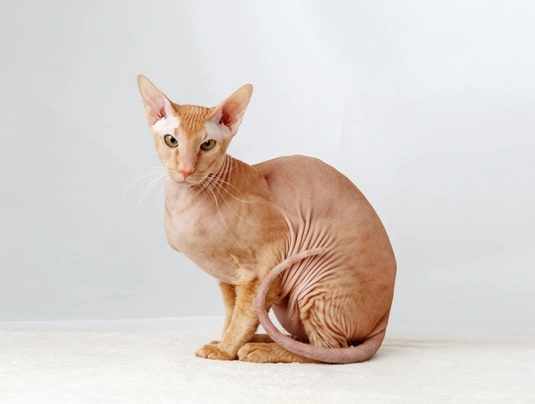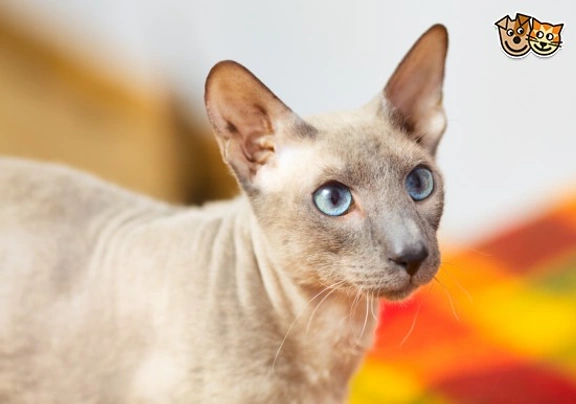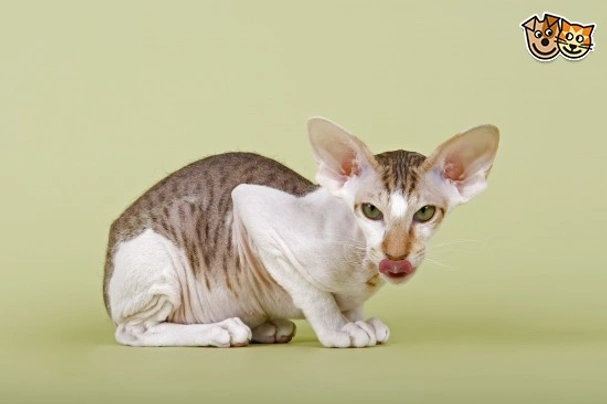Peterbald
Introduction of the Peterbald
The Peterbald is a relatively new breed of small to medium sized cat the first of it's type having been bred in Russia in 1993. The breed can be referred to as a Russian Sphynx which can sometimes be a little confusing with the Don Sphynx being called a Russian Sphynx too. Peterbalds are elegant slim and graceful cats taking many of their traits from their parentage namely the bald gene of the Don Sphynx and the gracefulness of the Oriental Shorthair and Siamese. They are slender cats with lovely almond-shaped eyes and large bat-like ears. The breed boasts a thin whip-like tails and elegant oval paws which means they can pick objects up and grasp them including levered door knobs. Peterbalds are very similar looking to Oriental Shorthairs but when born they can be bald velour flocked brush or straight coated with the breed having the hair-losing gene. The cats born with hair straight-coated cats being the exception may lose their hair as they age. Peterbalds come in a variety of colours as well as markings. Peterbalds can live for 10 or more years if well looked after.
History of the Peterbald
The breed originates from St Petersburg Russia when a brown mackerel tabby Don Sphynx called Afinguen Myth was bred with a tortoiseshell Oriental called Radma Vom Jagerhof in 1993. The offspring proved to be extremely popular in St Petersburg where these hairless cats quickly became known as the Petersbalds. However a new bloodline came about as more people began crossing Peterbalds with Don Sphynx Oriental Shorthairs and Siamese. These great looking cats combine the bald gene of the Don Sphynx with the elegance that's so typical of the Siamese and Oriental Shorthair creating a distinctly unique looking feline. In 1996 the Peterbald as a breed was then accepted by the Russian Selectional Feline Federation (SFF) being given the abbreviation of PBD. By 1997 the breed was accepted in the International Cat Association (TICA) and given an abbreviation of PD. In 2003 the World Cat Federation (WCF) accepted the breed giving it the abbreviation of PBD. Other abbreviations the breed are referred to by are PTB PD and PSX. Modern Peterbalds lean more towards Oriental and Siamese types. Breeders are encouraged to mate Peterbalds with Orientals and Siamese cats as well as semi-longhair types. As of May 2009 Peterbalds were accepted for Championship class competitions but a year earlier in 2008 the American Cat Fanciers Association (ACFA) accepted the breed too. TICA recognises the “brush coat” Peterbald as a breed that can be entered into Championship competitions.
Appearance of the Peterbald
Peterbalds are extremely elegant cats with a slim graceful yet muscular build. The breed boasts long narrow heads with a straight profile and appealing almond-shaped eyes. Their muzzles are wedge-shaped and their ears are large and bat-like. Their tails are like whips and they have webbed feet. When it comes to the shape of their paws these are oval which allows Peterbalds to grasp items and objects they are very adept at opening doors with levered handles. Males of the breed weigh in at anything from 8 to 10 lbs with the females being slightly lighter only weighing between 6 to 8 lbs. The breed boast five sorts of coats the Ultra bald cats are born bald and remain bald throughout their lives. The Flock or Chamois coated cats are 90% hairless although they may have some down on their extremities and their whiskers and eyebrows are curled kinked and sometimes even broken. The Velour Coated cat boasts around 70% of their bodies having a coat that can reach up to 1 mm long but from a distance the cats look hairless. This is because the skin shows through it. The coat may change to a more Flock/Chamois texture with age. Brush coated Peterbalds have more wiry hair that is sometimes a tiny bit wavy or it could even be positively curly measuring up to 5mm in length. Kittens with light brush coats may go bald by the age of two. However kittens with heavier denser brush coats usually remain the same. All Peterbalds boast curled or kinked whiskers with the exception of the straight coated cats. Peterbalds with straight coats don't have the hair loss gene and will keep their short coats all through their lives and they have straight whiskers.
Temperament of the Peterbald
Peterbalds boast having very sweet natures and are known to be affectionate quiet yet very inquisitive characters. They are highly intelligent creatures that bond well with their owners. They are also very energetic and need to be kept busy. Peterbalds love the sound of their own voices and like to let owners know when they're happy when they purr extremely loudly. They also love to follow owners around just so they can be near them. The breed is very social and usually gets on well with other cats and pets. They are also very good around children.
Intelligence / Trainability of the Peterbald
To date Peterbalds are not recognised by all cat registries and due to the fact the breed is such a new one there has been some concern over genetically inherited diseases with feline ectodermal dysplasia in its homozygous form being the main one. This causes dental health issues and a compromised ability for the breed to lactate but time will only tell if Peterbalds are more predisposed to certain inherited diseases.
Children and other
Because Peterbalds are hairless cats they need regular bathing so any grease or dirt is removed and as such prevents it from building up on their skin. Bedding needs to be frequently washed just as you would your own bed linen. Ultra bald cats tend to be a lot oilier and therefore need bathing more frequently but you need to be very careful not to overdo it because over-bathing may lead to the cat's skin becoming too dry. You need to pay special attention to the ears and nail beds to remove any build up in both of these areas of the cat's body. The same applies to their web paws and especially between their toes. Some cats need to have their tails washed daily to prevent any blackheads forming. But it is usually just once a week that Peterbalds need to have a bath and then just wiped down every day using gentle baby wipes. In the summertime Peterbalds need to be kept out of direct sunlight because they burn very easily. When it comes to feed they are pretty easy but they do need a well thought out balanced diet. Feeding good quality food is essential and if feeding a kitten you would need to discuss their nutritional needs with the breeder. Peterbalds have a higher metabolism than other cats which means they have higher body temperatures around 40-41 °C. Because of this any wounds and scratches they might have will heal a lot quicker and better than other breeds who have a lower body temperature. Cat breeders are still allowed to breed Don Sphynx cats with Peterbalds but this is generally avoided because it can prove very difficult with a high mortality rate. Bald kittens need very special care. Peterbalds are not suitable pets for people with allergies because these may be triggered by the cats saliva from skin dander and from the small amount of coat the cat may have on their bodies.


